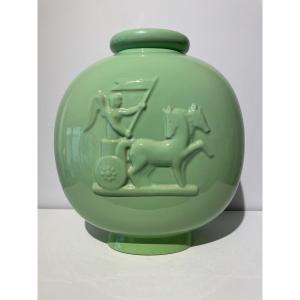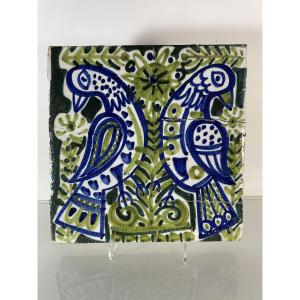"Jean Tirilly (1946-2009) - Acrylic On Mounted Canvas"
- A work close to the "beginnings" of Jean Tirilly in painting with this large canvas mounted on panel.
- Signed lower left and probably dating from the years 1993-1994, not codexed like many of Jean's works.
- Dimensions: 80 cm high x 85 cm with frame, 75 x 80 without.
- A much more abstract work, a compulsive desire to paint, a superb polychromy ...
- Jean Tirilly is a key player in Art Brut and Art Singulier, he has exhibited in Germany, Switzerland, Belgium, France. His works have been integrated into "The collection of Art Brut" in Lausanne. They (and he) have especially touched many amateurs and collectors. Although this artist left us recently, it is estimated that he must have produced around 2000 paintings and beyond 1000 drawings.
- A compulsive, diligent, dedicated creator." If the word "singular" has a meaning, it is to the painting of Jean Tirilly that it can be applied. I see quite a few images passing by. Rarely have I discovered a world so enigmatic and alive at the same time. Obvious, fascinating, and completely unexpected, unpredictable. A brilliant work is first of all a surprise. It seems to come from elsewhere, from an unknown planet. And like a gift of life, it always gives more than one would have the right to expect. There are paintings that seduce you immediately. Over time, you tire of them. The more you look at them, the more they become exhausted. In the end, you see too much where it comes from, how it is made. What we liked at first suddenly seems poor, elementary, lacking mystery and complexity... I found in Tirilly's astonishing works the complete opposite, a complete, inexhaustible world, resistant to pure analytical understanding, like lifeI only visited Jean Tirilly once, finally giving in to the pressure of his admirer. He had been described to me as living like a recluse, but he was indeed a great solitary man, entirely devoted to the daily exploration of his inner world; a sailor on a cargo ship from sixteen to twenty-two years old, then, among other things, a dishwasher in a restaurant to one day afford himself the freedom to paint. Tirilly is a child of the 70s, who first wanted to be a writer and published poems with small publishers in the region. For the past ten years or so since he started painting, he has always worked in acrylic, generally on paper, more rarely on canvas, or even on the back of an oilcloth, and he creates his images from a black background, like a photo in the developer… How can one describe these human mêlées, this teeming life, this frenetic and colorful match that Tirilly's paintings depict? With these faces, masks with hollow eye sockets, mouths always open, like burst pumpkins or old broken locks, the clever play of colored interlacing, stylizations of bodiless arms and legs, and the glimpses of the sky or the sea or pieces of rural scenery, bits of landscapes, houses, villages, treated to the minimum, as in the backgrounds of the Italian primitives. A world of joyful dying, of effervescent undead, of zombies on a spree closer to the ballad of the hanged or a festive vision of the last judgment than to the profane frivolity of the Commedia del arte. Because the very skillfully mastered color is deceptive in the universe of Tirilly, where the grim reaper prowls, the ankou of the parish enclosures, with a comic strip coloring. A monstrous Halloween, Jean Tirilly's tournaments and pitched battles are a puppet theater where life and death are played out in a raging stadium. "Art must always make people laugh a little and scare them a little," said Dubuffet. It is from this ambiguity that all the tension that makes Jean Tirilly's images so powerful is born. A very mental art, condensed with life, where in a symbolic writing of great coherence, this Villon of painting, a great poet of an era of change, offers us, with a minimum of accessories - a child's boat to represent the sea, a steering wheel to evoke a car - beautiful non-verbal fables on the current ups and downs of the human condition. The truth is always bitter like medicine; it must be sugar-coated to make it go down. This is the whole game of art, which spontaneously knows how to get to the heart of the matter and conceal the drama under a shimmering exterior. Laurent Danchin 2002"










































 Le Magazine de PROANTIC
Le Magazine de PROANTIC TRÉSORS Magazine
TRÉSORS Magazine Rivista Artiquariato
Rivista Artiquariato